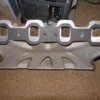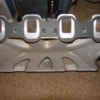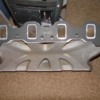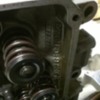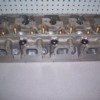[QUOTE]Originally posted by Looftie:
I appreciate your input. You definitely raise good points. In your estimation, what would a set of virgin A3 heads typically go for (before shipping)?
I've seen two sets recently but the one on ebay a couple of weeks ago scared me away (guides were knocked out, one chamber was missing valve seats and had been peened around both seats).
I'm not 100% set on the A3s. Trickflow, CHI or AFD might end up being a bit cheaper to get up and running and probably have a better combustion chamber design. I don't normally flip Cleveland stuff but if there is value, maybe.
There is just something about the A3s being a Ford Motorsport part and having some of the '70s prostock "fixes" that appeals to me. It's probably not the most practical choice for me. In an alternate universe, had the Cleveland not been axed, I could see it eventually going to a production aluminum head with raised ports (maybe not as big as an A3 though).
[QUOTE]
FYI, the b351 head is a smaller port version. It probably would be a better street head. It is more specifically tuned to the 351 then the A3 is. It was designed to use smaller valves though.
Some would say the C302 versions would be best for the street but if you look at the port size they are very close to the port dimensions of a 302W head. I think you need a flow bench, a GREAT grinder to get them to work?
I would think that your A3 heads would be in the value range of what a current good set of top aftermarket heads bring? MAYBE more because of the Ford oval thing? Unfortunately for buyers, talk on this forum about them has perked a lot of interest and probably spiked the value just a bit? I am guilty of that as well.

I can't answer other than that. If my set needed to be replaced, I'd be interested but having said that, mine came off of a circle track race car and had already been prepared for that.
For one thing they were shaved in order to get the chamber volumes down to 60. So I'd have some work to do on brand new box stock heads.
They DO need some relatively minor work done to them like shaving them in my opinion.
Maybe put them up for sale here for "best offer"?
See if that brings you an offer that you can work with to switch heads?
Incidentally, I agree with you on having the Ford oval on the part. To me it's a plus. Not everyone cares about that though? They are seemingly developing a reputation making them more desirable similar to the 427MR & HR heads?
OOOOH! One other thing, the headers for these heads in your chassis may in fact qualify as a "nightmare".
I had these in my 68 GT350 and the headers had to be hand made.
I CAN tell you that Jay Bittle, aka, JBA, DID in fact make a set for that application and that if you call them the part number is still good BUT don't count on them having any? Just another consideration.
Those exhaust ports on all of those heads, i.e., A3, B351, C302 are all raised A LOT from the original 4v iron heads, and the angle of the port is UP, not down.
That takes some finagling to get right. Mostly the chassis is going to make you turn the exits as straight down as you can. A 1.71 exhaust valve needs a 2" primary tube. A 1.60 like on a C302 head would use a 1.75" primary tube.
Exactly how you are going to get 2" primary tubes on THOSE headers to fit that chassis is going to be like being an alchemist?
The original flow numbers test on the exhausts used a 3" radius stub tube(as I remember). The ironic thing about that though is that they flowed better that way then with a straight out "gasser" type of exit.
The point is that the "high port" aluminum heads of that series (of which the A3 is one) will work much better in a car like a Pantera then a Mustang/Cougar simply because you can do more with the exhausts in the Pantera.
The Mustang/Cougar chassis is VERY LIMITING to the headers and will negate getting the maximum from the exhaust port improvements of the head.
Most of the improvement provided with that head is from the significantly better exhaust ports vs. the 4v iron heads.
You just can't take an existing set of headers for a 351-4v in that car, and change the flanges and expect them to bolt up. For one thing you won't find pre-made 2" primaries. 1-3/4", yes.
Lastly, the A3's show that they work better with more cubes like a 383, etc, then a 357. Frankly for me though, you won't hear any complaints here.
What ALL the NUMBERS showed was that the B351 head was noticibly better. For me, they noticibly sucked. The A3 was better. Not just a little. Quite a bit but then again I liked the Torker with a 750 DP Holley BUT the Torker LOVES a 12.0:1 engine. I can't do that any more.
Keep in mind though that all of this information just proves to many others that I am loosely hinged in reality which really is good for me. They are all afraid to talk to me and leave me the F... alone. That definitely CAN have benefits. So just take this all with a grain of salt.

Just food for thought?



